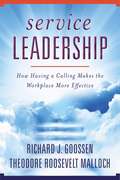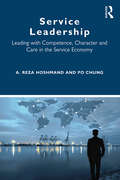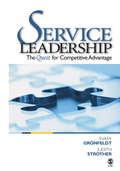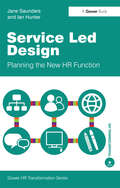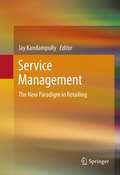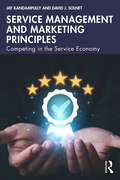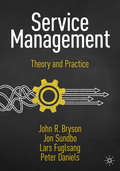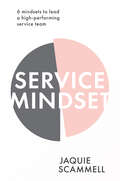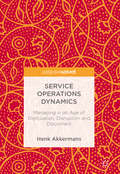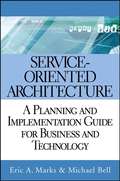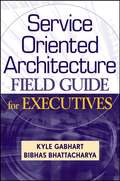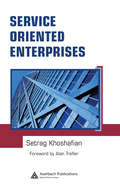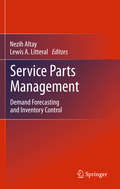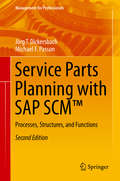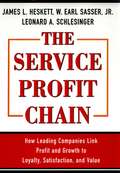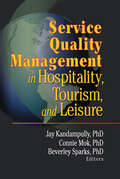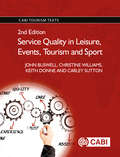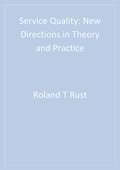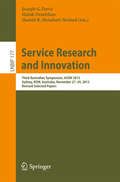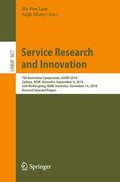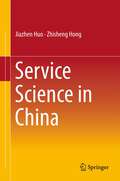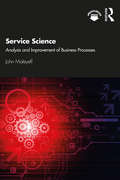- Table View
- List View
Service Leadership: How Having a Calling Makes the Workplace More Effective
by Theodore Malloch Richard J. GoossenWhat will motivate an organization’s employees to be fully engaged in the corporate purpose? How can a company be more supportive of each individual’s pursuit of workplace meaning? Service Leadership answers these questions and more. “Service leadership” is the recognition and cultivation of the varied interests and beliefs of employees on their quest for purpose at work. An organization will not get the most out of its staff unless it respects each individual’s framework for the pursuit of meaning, which is often done in the context of spirituality and religion. Service leadership takes many forms and is not the same for everyone. People can and want to learn how to become service leaders. Service Leadership shows how these ideas can be implemented through a detailed framework. Extensive research confirms that organizations that do not address the existing core belief systems of employees will be disadvantaged in the marketplace. Interviews with top executives at organizations like Whole Foods, Facebook, Gloria Jean’s Coffee, and Costco shed light on how both companies and employees can utilize service leadership to find and keep meaning in the workplace, improving both job happiness and performance.
Service Leadership: Leading with Competence, Character and Care in the Service Economy
by Po Chung A. Reza HoshmandService Leadership offers students, researchers, and leaders a leadership model originating in the service economy – but which is gaining ground in all sectors and industries – explained by experts that were key actors in that origination at DHL International. Designed for undergraduates and graduates but also useful for professionals in leadership positions, Hoshmand and Chung structure the book around the 3Cs of leadership in the service economy: Competence, Character, and Care. It shows how the integration of the 3Cs when applied in combination with each other creates an environment of trust within and outside the organization. Most importantly, it allows the reader to understand how a move from the manufacturing mindset (hierarchical decision making) to a service mindset (collective, qualitative, culturally sensitive) creates an ethical habitat and ecosystem that contributes to a firm’s competitiveness and adds value to its brand image. Incorporating elements of leadership literature, philosophy, psychology, sociology, economics, and political science, including cases, and supported by a teaching manual and a full set of slides, this book is ideal core reading for students of service leadership and leadership in the service economy, and valuable to those learning about leadership more broadly.
Service Leadership: The Quest for Competitive Advantage
by Svafa Gronfeldt Judith Banks StrotherThe purpose of this book is to provide a comprehensive theoretical framework as well as practical strategies—not just for survival but for a true search for excellence in the uncertain and ever-changing world of customer service management. The theoretical framework is based on the notion that customer service contains three key variables: a promise, a process, and people. After going through the step-by-step process of service management, the reader will have the necessary understanding and skill to choose the right strategy for the right circumstances, to design service processes, to identify the means and methods to implement these processes, and to measure the outcome.
Service Led Design: Planning the New HR Function (Gower HR Transformation Series)
by Ian Hunter Jane SaundersFor many years now, both private and public sector organizations have been dealing with the challenge of how best to improve corporate performance. HR has not escaped this scrutiny. The very same businesses that have spent recent years cost cutting, restructuring and streamlining, are putting the pressure on the HR 'overhead' to prove that it is not just a cost centre but a function that provides added value through alignment to business needs and aspirations. The traditional, transaction-based HR service must, however, still be delivered. Understanding how to combine a renewed strategic focus with effective delivery of transactional and administrative services is the key to HR's next generation of service delivery models. The authors' work with HR functions includes an established set of service design criteria and an approach that differentiates between a successful implementation and what can be a costly backward step that only serves to alienate the business. They show how any prospective HR transformation should consider five fundamental issues in the service design phase to align the HR approach to the business strategy. These issues are critical to ensuring a fit for purpose HR function that can measure and demonstrate the value it adds. About The Gower HR Transformation Series: The Human Resources function faces a continuing challenge to its role and purpose, in many organizations it has suffered from serious under-representation at strategic, board level. Yet, faced with the challenges of globalism, the need to innovate, manage knowledge, attract and retain the very best employees, organizations need an HR function that can lead from the front. The process of transforming the function is complex and rarely linear. It involves designing a function that can manage its generalist and specialist roles with equal skills. The Gower HR Transformation Series will help; it uses a blend of conceptual frameworks, practical advice and global case study examples to cover each of the main elements of the HR transformation process. The books in the series follow a standard format to make them easy to read and reference. Together, the titles create a definitive guide from one of the leading specialist HR transformation consultancies; an organization that has been involved in HR transformation for clients as diverse as Bombardier Transportation, Marks & Spencer, Barnardo's, Oxfam, Schroders, UnitedHealth Group, Nestlé, BP, HM Prison Service, Transport for London and Vodafone.
Service Management
by Jay Kandampully"Great retailers are great at service. No exceptions. This book offers a wealth of insight into delivering excellent retail service." ---Leonard L. Berry, Distinguished Professor of Marketing, N.B Zale Chair in Retailing and Market Leadership, Mays Business School, Texas A&M University "With a growing understanding of service as a phenomenon and perspective of business and marketing, retailers are increasingly seeing the need to transform from distribution of products to service providers. This book includes considerable insight regarding the importance of the service perspective and how it can be implemented in retailing." --Christian Grönroos, Professor of Service and Relationship Marketing, CERS Centre for Relationship Marketing and Service Management, Hanken School of Economics, Finland "Consisting of chapters written by leading scholars in service management and retailing from around the world, this comprehensive book offers rich insights for how retailers can excel and achieve sustainable competitive advantage by invoking and implementing service management principles. This enlightening book is a valuable resource for students, researchers and practitioners with an interest in retailing." --A. "Parsu" Parasuraman, Professor of Marketing & The James W. McLamore Chair, School of Business Administration, University of Miami Coral Gables, Florida "Service excellence and service innovation are critical for success in today's competitive retail marketplace. Service Management: The New Paradigm in Retailing provides a contemporary and transformative lens for accomplishing these essential goals." --Mary Jo Bitner, Professor, Director Center for Services Leadership, W.P. Carey School of Business, Arizona State University
Service Management and Marketing Principles: Competing in the Service Economy
by Jay Kandampully David J. SolnetThis book explores the service economy and challenges that all organizations face as goods and services make way for a world where customers (B2C) and businesses (B2B) seek seamless, thoughtful, and exceptional experiences. This book introduces readers to a range of interrelated topics and the application of service management and marketing theories which are fundamentally critical to the success of all enterprises seeking competitive advantage through enhanced customer experience.This book analyses management and marketing challenges in the service and experience economy and provides insights into how marketers and managers can strike a balance between supply, demand, price, and quality and leverage technology for operational efficiency and to better manage customer service and expectations. Through the coverage of critical foundational topics, from how value is created; the evolution of global economies from goods, services to experiences; foundations of customer-centric management; managing service workers; integrating human touch with high-tech service; and many others, the authors provide a holistic understanding of management in a complex, globally interconnected world. This book will be useful for students, researchers, and instructors of business management, marketing, commerce, and economics. It will also be of interest to professionals working in healthcare, retail, financial services, government hospitality, leisure, tourism, and other services.
Service Management: Operations, Strategy, Information Technology
by Sanjeev Bordoloi James Fitzsimmons Mona FitzsimmonsThe purpose of this book is to provide cutting-edge information on service management such as the role services play in an economy, service strategy, ethical issues in services and service supply chains. It also covers basic topics of operations management including linear and goal programming, project management, inventory management and forecasting. This book takes a multidisciplinary approach to services and operational management challenges; it draws upon the theory and practice in many fields of study such as economics, management science, statistics, psychology, sociology, ethics and technology, to name a few. It contains chapters most textbooks do not include, such as ethics, management of public and non-profit service organizations, productivity and measurement of performance, routing and scheduling of service vehicles.
Service Management: Theory and Practice (Research Handbooks In Business And Management Ser.)
by John R. Bryson Lars Fuglsang Peter Daniels Jon SundboThis textbook offers a fully integrated approach to the theory and practice of service management, exploring the operational dynamics, management issues and business models deployed by service firms. It builds on recent developments in service science as an interdisciplinary research area with emphasis on integration, adaptability, optimization, sustainability and rapid technological adoption. The book explores seven fundamental processes that are key to successfully managing service businesses, helping students gain insights into: how to manage service businesses, with coverage of both small firms and large transnationalsservice business models, operations and productivitymanaging service employeeshow service firms engage in product and process innovationmarketing, customers and service experiencesinternationalization of service businessesthe ongoing servitization of manufacturing This unique textbook is an ideal resource for upper undergraduate and postgraduate students studying service businesses and practitioners.
Service Mindset: 6 mindsets to lead a high-performing service team
by Jaquie ScammellIf you're looking to transform the customer service culture in your organisation, to decrease complaints and increase compliments, Jaquie Scammell's approach is simple and more human than simply introducing better processes and procedures and her approach works.Jaquie has studied organisations that provide the best customer service and from this research she has created a system which, if followed, will increase loyalty to your business. You too will be able to create a winning customer service mindset that will be adopted by your frontline service leaders, the people who impact your customer service staff, who impact your customers every day.In Service Mindset, Jaquie includes interviews with leaders from six of the best Australian businesses, which have a customer service mindset. These organisations may not have as much street cred as Google, Amazon or Facebook, but they lead the way when it comes to building a high performing service culture where customer loyalty is constantly increasing.
Service Operations Dynamics: Managing In An Age Of Digitization, Disruption And Discontent
by Henk AkkermansThis innovative book presents an up-to-date account of service operations, spanning topics such as IT-enabled services, service supply chain and volatility of demand and supply. Combining a systems perspective with a focus on service supply chains, the chapters provide a clearly framed set of mechanisms and theories with a focus on innovation-driven sectors and the game-changing role of IT. With each chapter built around real-life examples and service companies, the primary services supply chain is discussed alongside four key stakeholder groups: workforce, customers and markets, buyers and suppliers, and IT and innovations.
Service Oriented Architecture (SOA)
by Michael Bell Eric A. MarksPraise for Service-Oriented Architecture"This book provides a superb overview of the SOA topic. Marks and Bell provide practical guidance across the entire SOA life cycle-from business imperatives and motivations to the post-deployment business and technical metrics to consider. With this book, Marks and Bell demonstrate a unique ability to take the complex dynamics of SOA, and through an eloquent set of metaphors, models, and principles, provide an understandable and insightful how-to manual for both technical and business executives. This will become a required handbook for any organization implementing SOA."--Dan Bertrand, Enterprise Technology Officer & EDS Fellow, EDS Corporation"A fundamental breakthrough in the business and technology perspectives of SOA-this book belongs in every software developer, architect, and IT executive library. Marks and Bell demonstrate a creative and practical approach to building complex, service-oriented systems. I especially liked the hands-on perspective brought to multiple aspects of SOA. A must-have guide in the technology turbulence of the future."--Ariel Aloni, Chief Technology Officer, SunGard Data Management Solutions"This outstanding text gets straight to the heart of the matter, cutting through the hyperbole and discussing how to drive real business value through SOA. It will certainly impact my behavior, our governance models, and, subsequently, the successful business outcomes we derive as we continue to embrace SOA. A must-read for battle-scarred SOA veterans and fledgling architects alike."--Christopher Crowhurst, Vice President and Chief Architect, Thomson Learning"Too often, SOA has been perceived as 'all about the technology'-standards, technology stacks, operational monitoring, and the like. In this book, Marks and Bell expand beyond the technology to provide a refreshing business-driven perspective to SOA, connecting the dots between business requirements, architecture, and development and operations, and overlaying these perspectives with tried-and-true governance techniques to keep SOA initiatives on track. A must-read for those leading the charge to adopt SOA within their enterprise."--Brent Carlson, Chief Technology Officer, LogicLibrary and coauthor of San Francisco Design Patterns: Blueprints for Business Software"Marks and Bell have captured a wealth of practical experience and lessons learned in what has become the hottest topic in software development. In this book, they explain in detail what works and what does not, from procedural issues to technical challenges. This book is an invaluable reference for organizations seeking the benefits of SOAs."--Dr. Jeffrey S. Poulin, System Architect, Lockheed Martin and author of Measuring Software Reuse: Principles, Practices, and Economic Models"One of the last things companies often consider when implementing a business solution such as SOA is the impact on people. Marks and Bell provide an in-depth look at 'what has to change' from a process standpoint to make any SOA implementation a success. A great read for those considering to embark on an enterprise SOA and looking for the right mix of people, process, and products."--Alan Himler, Vice President of Product Management and Marketing, LogicLibrarySOA is a complex topic and a complex organizational goalService-Oriented Architecture: A Planning and Implementation Guide for Business and Technology shows you how to plan, implement, and achieve SOA value through its prescriptive approach, joining the business and strategic perspective to the technical and architectural perspective.Applicable to all industries, technology platforms, and operating environments, this innovative book provides you with the essential strategies to drive greater value from your SOA and realize your business goals.
Service Oriented Architecture Field Guide for Executives
by Kyle Gabhart Bibhas BhattacharyaService Oriented Architecture Field Guide for Executives is a fundamental breakthrough in the business and technology perspectives of service oriented architecture (SOA). A valuable resource to help you understand and realize the benefits of SOA in today's companies, this guide will show you how to plan, implement, and achieve SOA value. Use a prescriptive approach to help you clearly understand SOA and to determine its applications for your business. Applicable to all industries, technology platforms, and operating environments, this innovative book will provide you with essential strategies.
Service Oriented Enterprises
by Setrag KhoshafianExtending beyond the technical architecture to the very philosophy of how a business should operate, the Service Orientation approach establishes fluidity across boundaries to provide agility, transparency, and fundamental competitive advantage. Service Oriented Enterprises brings the concept of service orientation from the IT department to the boardroom, applying the precepts of service oriented technology to the underlying dynamics of how a business operates. Implementing a technological concept as a cultural paradigm, the SOE succeeds by combining the best features from virtual, extended, real-time, and resilient enterprises to serve not just its customers, but also its trading partners, shareholders and employees. Building primarily on the success of the Internet and the automation of business policies and processes, the Service Oriented Enterprise (SOE) is defined by three essential layers: the enterprise performance layer, the business process management layer, and the underlying service oriented architecture. This book focuses primarily on layers two and three and how the fundamental dynamics of a business can be altered when these concepts are applied to both architecture and culture. Beginning with an overview of the emerging SOE culture, the text contrasts the new service-oriented methodologies with traditional waterfall and iterative methodologies. Emphasizing Web Service strategies for description, discovery, and deployment techniques, the author goes deeper into service-oriented concepts describing the business process management suite as the central core of the SOE, and introducing the Enterprise Service Bus as the backbone for integration. The text describe how modeling, executing, and continuously improving the business process and business policies lends to the development of a common language between business and IT. The book concludes by expanding on these concepts and delving into the societal and behavioral aspects of the Service Oriented Enterprise.The reality of business is no longer one where change is an unusual phenomenon; today change is the norm and the capacity for consumer-sensitive, fluid transition is vital to business survival. Service Oriented Enterprises provides the key concepts to facilitate that change.
Service Parts Management
by Lewis A. Litteral Nezih AltayWith the pressure of time-based competition increasing, and customers demanding faster service, availability of service parts becomes a critical component of manufacturing and servicing operations. Service Parts Management first focuses on intermittent demand forecasting and then on the management of service parts inventories. It guides researchers and practitioners in finding better management solutions to their problems and is both an excellent reference for key concepts and a leading resource for further research. Demand forecasting techniques are presented for parametric and nonparametric approaches, and multi echelon cases and inventory pooling are also considered. Inventory control is examined in the continuous and periodic review cases, while the following are all examined in the context of forecasting: * error measures, * distributional assumptions, and * decision trees. Service Parts Management provides the reader with an overview and a detailed treatment of the current state of the research available on the forecasting and inventory management of items with intermittent demand. It is a comprehensive review of service parts management and provides a starting point for researchers, postgraduate students, and anyone interested in forecasting or managing inventory.
Service Parts Planning with SAP SCM™
by Jörg Thomas Dickersbach Michael F. PassonThis book focusses on the after sales business and presents the Service Parts Planning (SPP) solution which was developed by SAP in a joint effort with Caterpillar and Ford in order to address the specific planning problems of service parts. The book explains the processes, structures, and functions of this solution and is targeted at decision makers, project members and project managers who are involved in an implementation of SAP Service Parts Planning or for users who want to gain a better understanding of the state of art in spare parts planning and the SAP Service Parts Planning software.
Service Profit Chain: How Leading Companies Link Profit and Growth to Loyalty, Satisfaction, and Value
by James L. Heskett Leonard A. Schlesinger W. Earl Sasser Jr.In this pathbreaking book, world-renowned Harvard Business School service firm experts James L. Heskett, W. Earl Sasser, Jr. and Leonard A. Schlesinger reveal that leading companies stay on top by managing the service profit chain.Why are a select few service firms better at what they do -- year in and year out -- than their competitors? For most senior managers, the profusion of anecdotal "service excellence" books fails to address this key question. Based on five years of painstaking research, the authors show how managers at American Express, Southwest Airlines, Banc One, Waste Management, USAA, MBNA, Intuit, British Airways, Taco Bell, Fairfield Inns, Ritz-Carlton Hotel, and the Merry Maids subsidiary of ServiceMaster employ a quantifiable set of relationships that directly links profit and growth to not only customer loyalty and satisfaction, but to employee loyalty, satisfaction, and productivity. The strongest relationships the authors discovered are those between (1) profit and customer loyalty; (2) employee loyalty and customer loyalty; and (3) employee satisfaction and customer satisfaction. Moreover, these relationships are mutually reinforcing; that is, satisfied customers contribute to employee satisfaction and vice versa. Here, finally, is the foundation for a powerful strategic service vision, a model on which any manager can build more focused operations and marketing capabilities. For example, the authors demonstrate how, in Banc One's operating divisions, a direct relationship between customer loyalty measured by the "depth" of a relationship, the number of banking services a customer utilizes, and profitability led the bank to encourage existing customers to further extend the bank services they use. Taco Bell has found that their stores in the top quadrant of customer satisfaction ratings outperform their other stores on all measures. At American Express Travel Services, offices that ticket quickly and accurately are more profitable than those which don't. With hundreds of examples like these, the authors show how to manage the customer-employee "satisfaction mirror" and the customer value equation to achieve a "customer's eye view" of goods and services. They describe how companies in any service industry can (1) measure service profit chain relationships across operating units; (2) communicate the resulting self-appraisal; (3) develop a "balanced scorecard" of performance; (4) develop a recognitions and rewards system tied to established measures; (5) communicate results company-wide; (6) develop an internal "best practice" information exchange; and (7) improve overall service profit chain performance. What difference can service profit chain management make? A lot. Between 1986 and 1995, the common stock prices of the companies studied by the authors increased 147%, nearly twice as fast as the price of the stocks of their closest competitors. The proven success and high-yielding results from these high-achieving companies will make The Service Profit Chain required reading for senior, division, and business unit managers in all service companies, as well as for students of service management.
Service Quality Management in Hospitality, Tourism, and Leisure
by Beverley Sparks Connie Mok Jay KadampullyDoes your staff deliver the highest quality service possible?Customers today expect a very high overall level of service in hospitality, tourism, and leisure. Competition in these fields will thus be driven by strategies focusing on quality of service to add value, as opposed to product or price differentiation. Service Quality Management in Hospitality, Tourism, and Leisure highlights concepts and strategies that will improve the delivery of hospitality services, and provides clear and simple explanations of theoretical concepts as well as their practical applications! Practitioners and educators alike will find this book to be invaluable in their businesses and in preparing students for the business world.This essential book provides you with clear, comprehensive explanations of theoretical concepts and methods that will give you the competitive edge in this fast-changing field. Topics covered include: services management marketing operations management human resources management service quality management Service Quality Management in Hospitality, Tourism, and Leisure brings together an array of pertinent materials that will measure and enhance customer satisfaction and help you provide superior hospitality services, and groups them in easy-to-use clusters for quick reference.
Service Quality in Leisure and Tourism
by Christine Williams John Buswell Keith Donne Carley SuttonService quality is at the forefront of how the leisure, events, tourism and sport (LETS) sectors operate. An important consideration for any business, and therefore any student of the subject, this new edition of a successful textbook addresses the key points and principles of managing service quality across the industry sector. Fully updated and enhanced, it: - Covers areas such as the experience economy, capacity management and service culture, as well as methods for measuring quality and satisfaction. - Includes numerous case studies to help students apply classroom-based theory to practice. - Is packed with student-friendly pedagogy and full colour illustrations throughout to enhance the learning experience. Considering the underpinning theory of service quality, this book informs the reader of the practical application of service quality management tools and techniques in an industry with distinctive features and challenges. An invaluable read for students within the LETS sectors, it also provides a useful refresher for practitioners working in the industry.
Service Quality in Leisure, Events, Tourism and Sport (CABI Tourism Texts)
by Christine Williams John Buswell Keith Donne Carley SuttonService quality is at the forefront of how the leisure, events, tourism and sport (LETS) sectors operate. An important consideration for any business, and therefore any student of the subject, this new edition of a successful textbook addresses the key points and principles of managing service quality across the industry sector. Fully updated and enhanced, it: - Covers areas such as the experience economy, capacity management and service culture, as well as methods for measuring quality and satisfaction. - Includes numerous case studies to help students apply classroom-based theory to practice. - Is packed with student-friendly pedagogy and full colour illustrations throughout to enhance the learning experience. Considering the underpinning theory of service quality, this book informs the reader of the practical application of service quality management tools and techniques in an industry with distinctive features and challenges. An invaluable read for students within the LETS sectors, it also provides a useful refresher for practitioners working in the industry.
Service Quality: New Directions in Theory and Practice
by Roland Rust Richard L. OliverIn this book leading scholars and practitioners present the latest research and theory in customer satisfaction and services marketing with a wealth of stimulating ideas. Topics discussed include: the measurement of the managerial impact on service quality improvement; new methods of assessing the various elements of service quality; and philosophies of the nature of customer value. The diverse viewpoints of the contributors reveal the variety of emerging ideas on the subject of service quality.
Service Research and Innovation
by Haluk Demirkan Joseph G. Davis Hamid R. Motahari-NezhadThis book constitutes the thoroughly refereed proceedings of the Third Australian Symposium on Service Research and Innovation, ASSRI 2013, held in Sydney, NSW, Australia, in November 2013. Overall, eight research papers were carefully reviewed and selected from 18 submissions. They are multidisciplinary in scope and cover strategic, organizational, and technological dimensions, ranging from purely conceptual to concrete implementations and testing of service-related technological platforms. Taken together, these papers provide a snapshot of the critical concerns and developments in service-related research and cover some of the key areas of research focus.
Service Research and Innovation: 7th Australian Symposium, ASSRI 2018, Sydney, NSW, Australia, September 6, 2018, and Wollongong, NSW, Australia, December 14, 2018, Revised Selected Papers (Lecture Notes in Business Information Processing #367)
by Sajib Mistry Ho-Pun LamThis book constitutes revised selected papers from the Australasian Symposium on Service Research and Innovation, ASSRI 2018. The conference was held in two parts on September 6, 2018, in Sydney, Australia, and on December 14, 2018, in Wollongong, Australia. The 9 full and 2 short papers included in this volume were carefully reviewed and selected from a total of 26 submissions, covering a variety of topics related to service-oriented computing and service science. The book also includes 3 keynote papers.
Service Science in China
by Zhisheng Hong Jiazhen HuoA service economy era is coming! As the basic discipline of service dominant era, service science mainly studies common rules of service activities, aiming to provide theoretical bases for creating service value in the new era. The book, which integrates knowledge of service management, operational management, logistics and supply chain management, constructs a research system for this emerging discipline. Service science research system constitutes service philosophy, resource allocation, operational management and service technology. Many cases about China's service enterprises are incorporated in the book, in the hope of providing readers an insight into not only service science but also the development of China's service economy.
Service Science: Analysis and Improvement of Business Processes
by John MaleyeffTo remain relevant in today’s world, practitioners should presume that they have two jobs: first, to do their work effectively so that they provide value to the organization; second, to improve how the work is done so that their organization remains competitive. This book offers clear guidance to excel at this ubiquitous second job. Informed by an appreciation that most personnel that work in any firm, even firms that are manufacturing-oriented, routinely provide services as a key element of their jobs, this book explains how to provide and improve internal customer service, regardless of industry or role. It illustrates the common features, or service process "DNA," while providing a diverse set of examples to enhance understanding. Written by a pioneer in the development of principles and methodologies that address services in a structured and distinctive manner, this book stresses that service processes are distinctly different from manufacturing processes. Rigorous and practical, this book will appeal to students and professionals alike, in business, hospitality, industrial management, public health, and other fields. Online resources include Excel files that act as templates to help with quantitative analysis routines.
Service Science: Analysis and Improvement of Business Processes
by John MaleyeffTo remain relevant in today’s world, practitioners should presume that they have two jobs: first, to do their work effectively so that they provide value to the organization; second, to improve how the work is done so that their organization remains competitive. This book offers clear guidance to excel at this ubiquitous second job.Informed by an appreciation that most personnel that work in any firm, even firms that are manufacturing-oriented, routinely provide services as a key element of their jobs, this book explains how to provide and improve internal customer service, regardless of industry or role. It illustrates the common features, or service process "DNA," while providing a diverse set of examples to enhance understanding. Written by a pioneer in the development of principles and methodologies that address services in a structured and distinctive manner, this book stresses that service processes are distinctly different from manufacturing processes.Rigorous and practical, this book will appeal to students and professionals alike, in business, hospitality, industrial management, public health, and other fields.Online resources include Excel files that act as templates to help with quantitative analysis routines.
